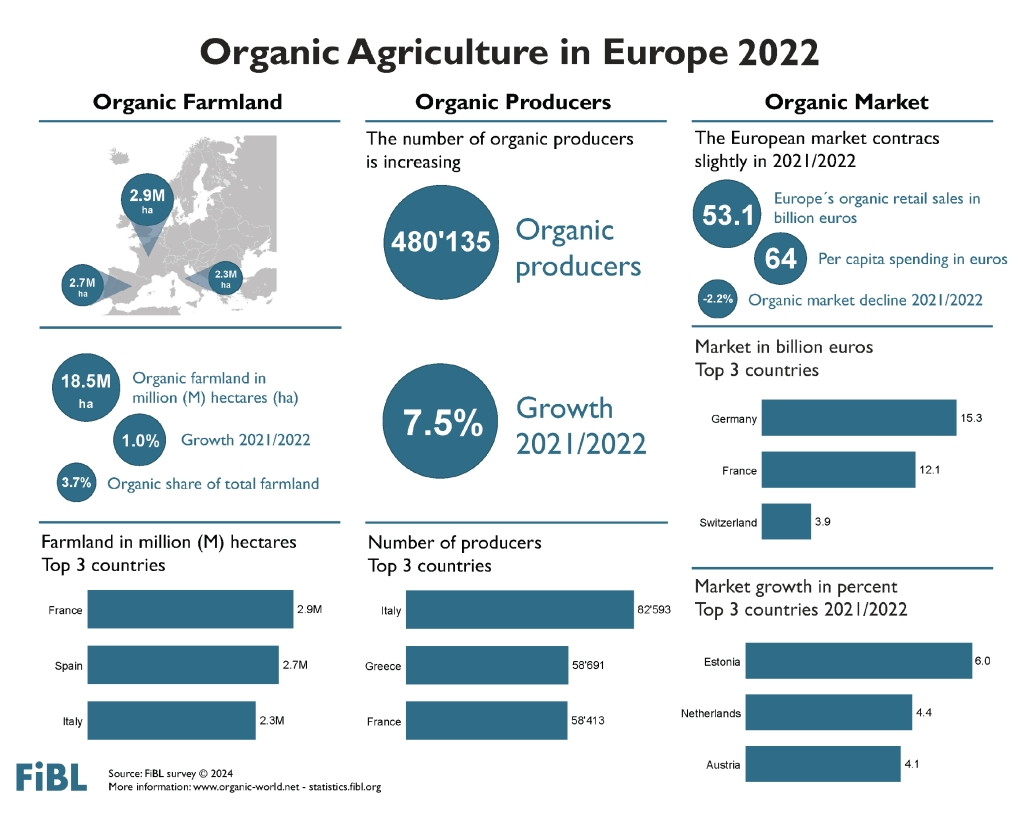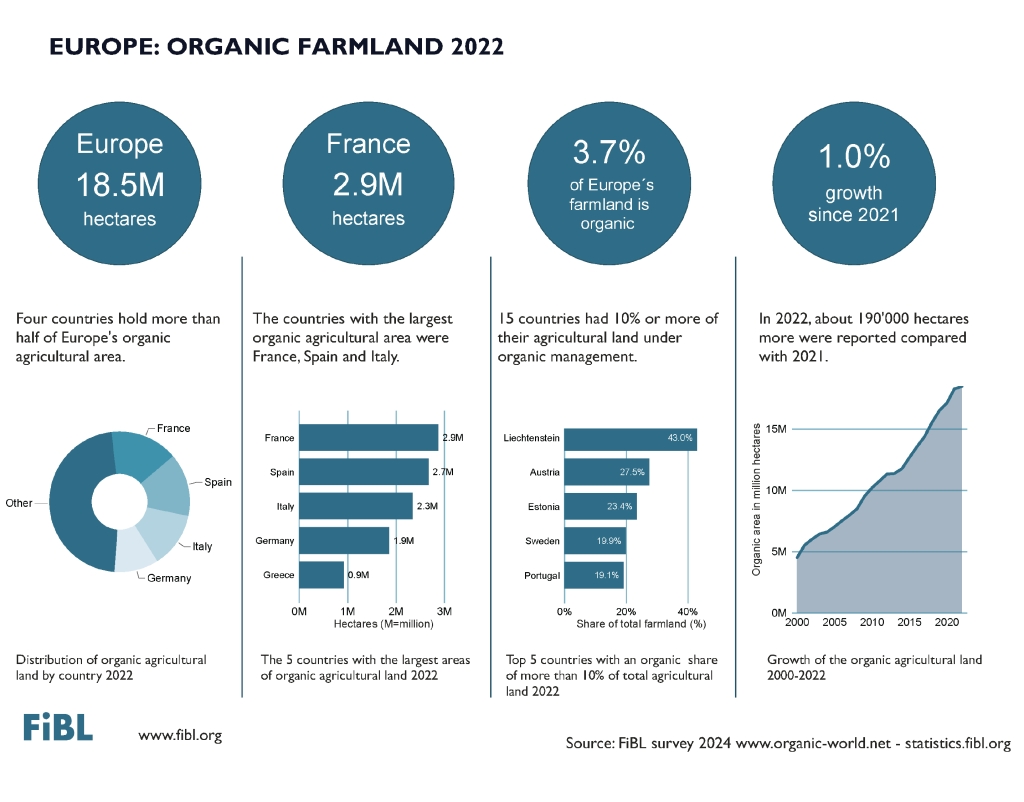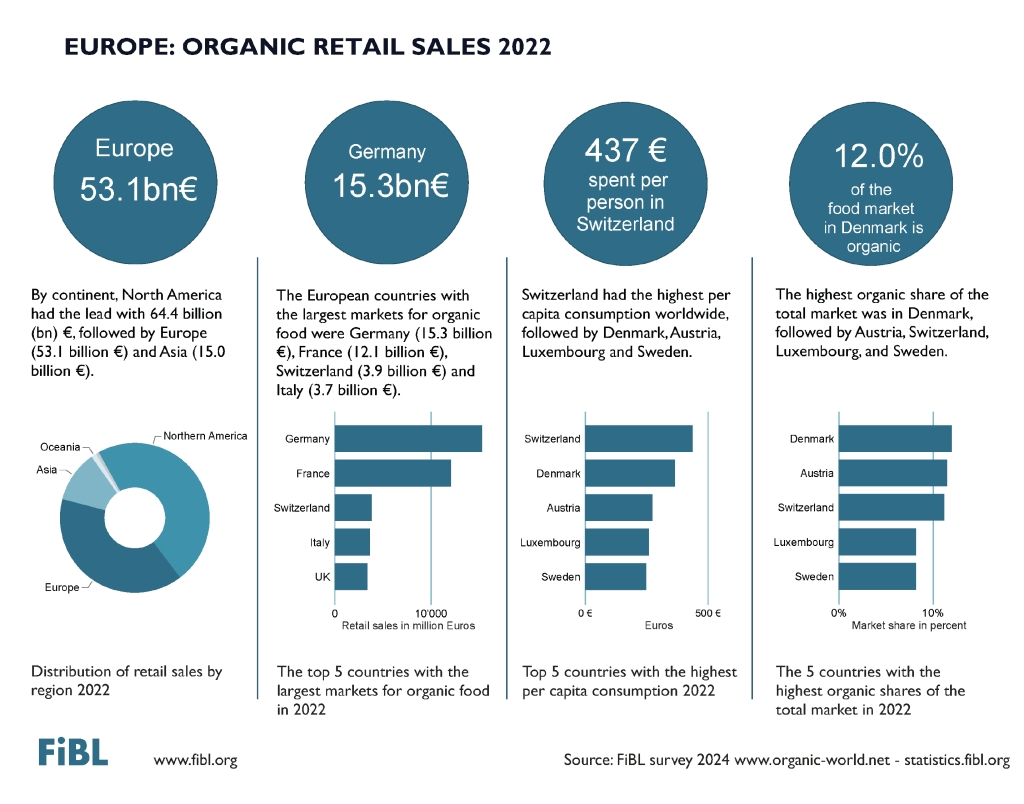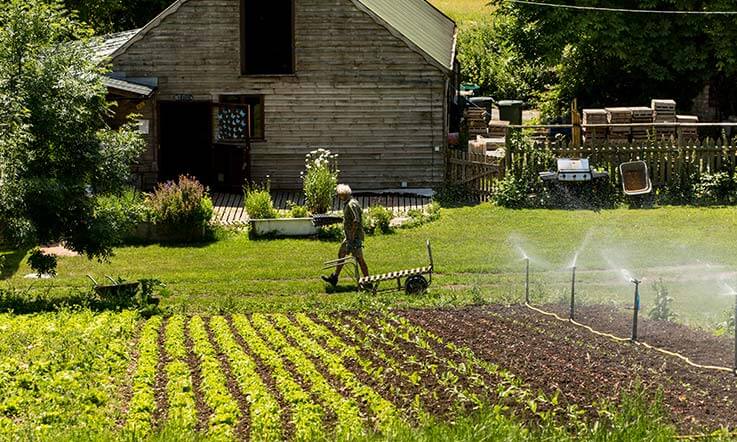Increasing by 5.1 percent, the European Union’s organic area continued to grow steadily in 2022, reaching 16.9 million hectares, which accounts for 10.4 percent of the total farmland. Retail sales, however, experienced a modest decline. The latest data on organic agriculture in Europe has been published in the yearbook ‘The World of Organic Agriculture.’

In 2022, 18.5 million hectares of farmland in Europe were organic (16.9 million hectares in the European Union (EU). France continued to lead as the number one country in terms of farmland under organic management with 2.9 million hectares, followed by Spain (2.7 million hectares), Italy (2.3 million hectares), and Germany (1.9 million hectares).
Organic farmland increased by more than 0.8 million hectares in the EU
Organic farmland increased by more than 0.8 million hectares, representing a 5.1 percent increase in the EU and a 1.0 percent increase in Europe. In comparison to 2021, Greece and Italy reported the largest increases, with 0.4 million hectares and 0.2 million hectares, respectively.

Liechtenstein led with the highest share of total organic farmland in the world
In 2022, organic farmland in Europe constituted 3.7 percent of the total agricultural land, while it accounted for 10.4 percent in the European Union. Among European countries and globally, Liechtenstein had the highest organic area share at 43.0 percent, followed by Austria, the EU country with the highest organic share at 27.5 percent. Fifteen European countries reported that at least 10 percent of their farmland was organic.
Organic producers in the EU increased by almost 10 percent
There were more than 480,000 organic producers in Europe and over 419,000 in the EU, representing an increase of 7.5 and 9.5 percent, respectively. Italy had the highest number with 82,593.
In Europe, there were 91,775 processors, while the EU had 85,956. Additionally, 7,609 importers were counted in Europe, with 6,450 in the European Union. Italy had the highest number of processors, nearly 24,000, while Germany led in the number of importers with more than 1,900.
Retail sales valued at 53.1 billion euros in Europe
Retail sales of organic products in Europe reached a total value of 53.1 billion euros in 2022 (45.1 billion euros within the European Union). Germany stood out as the largest market, boasting sales of 15.3 billion euros. Globally, the EU held the position of the second-largest single market for organic products, trailing behind only the United States, which reported sales of 58.6 billion euros.
In 2022, the European market experienced a 2.2 percent drop (EU: -2.8 percent). While several countries faced declining sales, noteworthy growth was observed in countries such as Estonia (+6.0 percent) and The Netherlands (+4.4 percent).

European consumers spent 64 euros per person on organic food in 2022
In 2022, consumers in Europe spent an average of 64 euros on organic food per person (102 euros in the EU). Consumer spending on organic food per capita doubled in the decade from 2013 to 2022. In 2022, Swiss and Danish consumers spent the most on organic food, with 437 and 365 euros per capita, respectively.
Denmark had the highest organic market share in the world Globally, European countries accounted for the highest share of organic food sales as a percentage of their respective food markets. Denmark continued to have the highest share worldwide, with 12.0 percent in 2022, followed by Austria with a share of 11.5 percent and Switzerland with 11.2 percent.
The yearbook “The World of Organic Agriculture – Statistics and Emerging Trends 2024” (352 pages) presents the results of the annual survey on organic agriculture worldwide and has numerous tables, graphs, maps and infographics. It contains reports by experts on the organic sector and information on emerging trends across all regions as well as selected countries. It also provides background information on standards and legislation, policy support, and the global market for organic food. Further information and download link are available at www.organic-world.net/yearbook/yearbook-2024.html.
Data collection
The data on organic agriculture is collected annually by FiBL in collaboration with many partners from around the world. The results are published jointly with IFOAM – Organics International. The activities are supported by the Swiss State Secretariat of Economic Affairs SECO, the Coop Sustainability Fund, and NürnbergMesse, organisers of the BIOFACH trade fair.
Book citation
Willer, Helga, Jan Trávníček and Bernhard Schlatter (Eds.) (2024): The World of Organic Agriculture. Statistics and Emerging Trends 2024. Research Institute of Organic Agriculture FiBL, Frick, and IFOAM – Organics International, Bonn. Available at www.organic-world.net/yearbook/yearbook-2024.html.
Where to download
The book can be downloaded at https://shop.fibl.org (order number 1747).
Online database and interactive infographics The data is available online at https://statistics.fibl.org.
